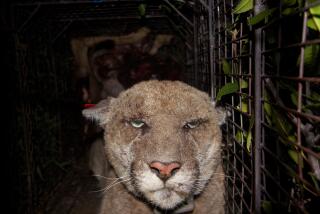Caused by Poisoned Gopher Bait : Spring Valley Upset by Dogs’ Deaths
- Share via
SPRING VALLEY — Bill Graham knew something was wrong when his 3-year-old German shepherd, T-Bone, didn’t come home Thursday night from his evening romp through the neighborhood.
Graham had raised the dog from a pup and knew that he always returned from his 20-minute run when he heard his master’s whistle. Graham whistled twice for the dog, but only his malamute, Tori, came home.
The next morning, Graham said, he found T-Bone lying dead beneath an avocado tree in a grove about 100 yards from his home.
Graham was devastated by the death, and he took the dog to the county veterinarian for an autopsy. The results showed that the dog had eaten a large quantity of strychnine-coated gopher bait.
Later that day, Karen Johnson, who lives in the same neighborhood on the southeastern edge of La Mesa, told Graham that her dog, a Labrador retriever, came home frothing at the mouth and died in her living room. Johnson’s other dog disappeared about a week ago and hasn’t been found.
The vet “found enough strychnine in my dog’s stomach to fill your fist,” Graham said. “We were worried about our other dog and it caused us to look into it,” added his wife, Jean, who was out of town when T-Bone died.
No other residents in the area have reported deaths of their pets but the San Diego County Humane Society is investigating. Lt. Jim Baker said the society gets few calls about animals dying from poisoning.
“If the animal ends up dying, it’s probably a pretty good dose depending on the weight of the
animal,” Baker said. The investigation is in its early stages, too early to tell whether the poisoning was accidental or intentional, he said.
Ray Rinder, assistant agricultural commissioner with the San Diego County Department of Agriculture, said that hardware and feed stores sell the strychnine-coated rodent poison in any quantity without restriction.
Rinder said his department also sells the poison, which is grain coated with strychnine and sold in one-pound cans. The department records the names and addresses of people who purchase it, Rinder said. However, other places that sell the poison are not required to keep records of their customers, he said.
The poisoned bran “has to be used for gopher control and it has to be placed underground,” Rinder said. “It’s not to be sold for anything else or be used for anything else. This is the safest way to use it, and this is the way we want people to use it.”
He acknowledged, however, that there is no way to police the use of the poison.
Rinder said that the poisoned bait can be purchased in amounts larger than a pound, but only if the buyer obtains a permit from the department and submits an explanation of how he plans to use it and for what purpose.
Jean Graham is not waiting for the results of a Humane Society investigation before taking action. She already has started handing out flyers in her neighborhood to warn neighbors of the danger to their pets, and perhaps to their children.
Graham is afraid of what she will find out when she completes her neighborhood canvass, but she feels that she must act quickly before other families lose their pets to a careless gopher tracker or a vengeful dog-poisoner--which ever is responsible.
“I’m going to ask everyone to please tell me if they lost a dog,” Graham said. “Who knows how many dogs have been killed?”
More to Read
Sign up for Essential California
The most important California stories and recommendations in your inbox every morning.
You may occasionally receive promotional content from the Los Angeles Times.










